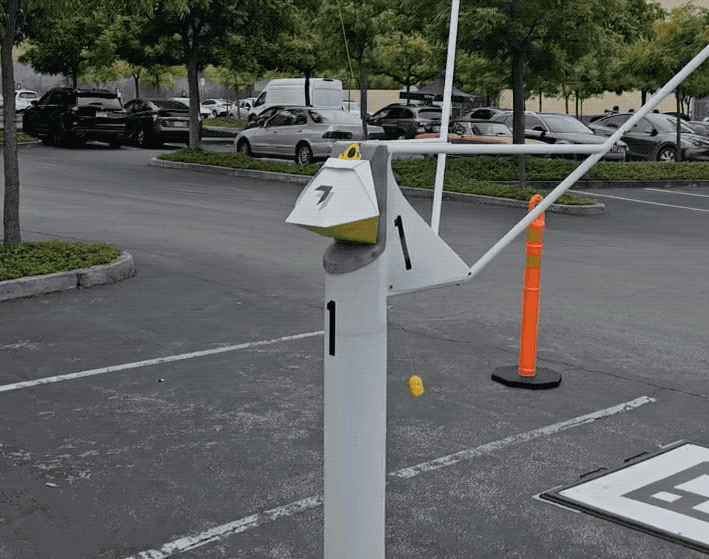In many ways, drone delivery still feels very pie in the sky in terms of scalable e-commerce. In smaller, controlled pockets, however, the concept is going swimmingly. Among the spots is a small Google satellite campus in the Palo Alto foothills. The buildings, which neighbor larger Tesla and HP offices, are home to a handful of Google divisions, including Nest and Wing (an accidental theme, one imagines).
Fixed-wing drones are a regular sight in the tiny airspace, courtesy of the latter. The front parking lot is quickly converted into a launch pad for testing these systems and various related mechanisms. Wing rolled out a handful of its delivery planes when I paid the company a visit this week, in part to demonstrate its new system.
Parking lots are an ideal launch pad in a rural area, assuming you’re able to block it off from cars. They’re ubiquitous and offer an unobstructed path for vertical takeoffs. As such, it’s unsurprising that they’ve become foundational to the company’s approach to bringing delivery to dense suburban areas.
It’s a market the young company has been focusing on for some time. I’ve long suggested that the ideal application for these technologies are more rural areas and places with insufficient travel infrastructure. It makes a lot of sense for emergency deliveries in spots with impenetrable roads.
“My belief on this is that delivery is always going to require a bunch of different offerings, in the same way that, if you show up to an airport, there are short-haul flights and long-haul flights and there are aircraft designed to take 300 people across an ocean,” CEO Adam Woodworth tells me as we watch the team prepare for launch. “The market segment that we focus the most on is dense suburban, getting close to rural. There’s an immense amount of demand there. That’s where people get the sort of order numbers that skyrocketed over the pandemic.”
The pandemic also saw an emergence of curbside pickup. As many establishments temporarily closed and consumers continued to fear exposure, it became a quick and easy middle ground between online and in-store shopping. While it largely seemed temporary, many stores have maintained what’s proven a popular option — particularly in suburban markets.
The prevalence allowed Wing to rethink an approach that had previously relied on an employee to be present for the drone handoff.
Image Credits: Wing
“The original idea for this was: Could you just bolt it to the [curbside pickup] sign?” says Woodworth. “The opportunity exists with the existing workflow. How can you make it so the airplane works like a car that’s driving up? How do you make it so the plane picks up the box, rather than the person having to time sync it there? It took a long time to get a robust mechanical solution for that that didn’t require more electronics.”
In spite of the name, the AutoLoader is a fully passive system. It’s stands roughly four feet tall, not including the two PVC pipes that jut out the front like a pair of horns. Operation is simple. Once the order is placed, an employee packs it into a cardboard box with a plastic ring on top that looks a fair bit like a Happy Meal. Loading it onto the rig is simple: you place the two pegs on the AutoLoader through a pair of holes in the box.
When the drone comes by, it hovers over the AutoLoader for a bit, to scope out the situation and make sure everything looks right. If it encounters an issue that it can’t correct for (say the employee forgot to load up the package), it will return to the hub. One downside of the fully passive system is that it can’t alert the drone or operates to potential issues.
If everything looks good, the drone lowers a tether, while the two poles ensure that it doesn’t drift too far from the target. Once the tether is properly positioned underneath the box, it begins to retract, snapping the payload up like a fishing wire, pulling it up for the journey. Once the drone reaches the pickup spot determined by the customers, it lowers the box gently to the ground. This area needs to be roughly six by six feet, with no foliage obscuring the area.

Image Credits: Brian Heater
Granted, the length of the Wing building is significantly shorter than the journey these drones will take in the wild, but things went swimmingly the first demo. The Wing rep opened the box and I helped myself to the banana inside, thus spoiling my lunch. Suddenly it occurred to me that there was an even better way to test the cargo. I asked one of the Wing employees to grab a soda.
The drone repeated the journey (though the specifics of its approach are somewhat randomized) and lowered the cargo. The Wing employee opened the box, grabbed the Coke bottle inside and popped off the cap. There was no exploding foam — a definite positive sign. He took a swig for posterity.

Image Credits: Brian Heater
“We expect that, by the end of the year, we’ll be rolling these out in parts of our operation,” says Woodworth. “And then by mid-next year, the full delivery network with have them.”
Wing doesn’t give specifics on the number of drones currently in operation. Instead, the company quantifies growth by the number of deliveries it has completely. It’s done more than 340,000 of those, and says it’s built “thousands” of drones over the course of its existence. Australia makes up the bulk of its deliveries, followed by the U.S., with Europe trailing at a distant third.
How curbside pickup caused Wing to rethink its approach to drone delivery by Brian Heater originally published on TechCrunch
Source : How curbside pickup caused Wing to rethink its approach to drone delivery










